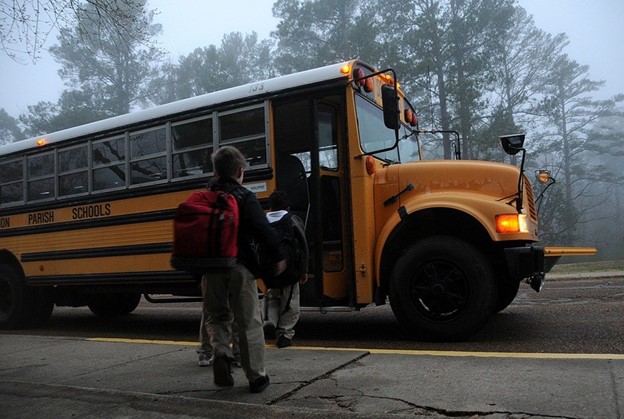
Image Credit: ebpilgrim / Pixabay
You probably remember the predicament of school bus bullying well from your days at school. Maybe you were picked on while riding the bus, maybe you witnessed someone get bullied on the bus, or maybe you're now a reformed school bus bully.
Whatever the case, you know that school buses are a common location for bullying to take place -- and you're probably concerned about how you can protect your child and their friends from the aftermath of school bus bullying. Here's how parents, kids, bus drivers, and schools can work together to make the school bus bully-proof.
Why Bullying Happens on the Bus
As of 2015, 1 in 4 students was a victim of bullying.
It's well known among children and adults that the school bus is one of the top locations for bullying to occur. Bullies tend to choose locations where adult supervision is low to pick on their peers. Without teachers or parents to monitor their behavior, and with the bus driver often limited in their ability to enforce school policy (especially while driving), the bus can become a breeding ground for bullying and other bad behavior.
Likewise, children are limited in their ability to escape bullying on the bus, meaning the bully has their target right where they want them. As a result, many bullies choose the bus as the primary location to torment their victims.

Image Credit: Counselling / Pixabay
How to Prevent School Bus Bullying
What Parents Can Do
One of the most important things you can do as a parent is to learn to recognize the signs that your child is being bullied. Children who are bullied often feel afraid to "tattle," for fear of retaliation from their tormenter. As a result, they may go to great lengths to hide the fact that they are being bullied, even from trusted parents.
When bullying is kept secret, it may manifest itself as physical symptoms such as nausea, stomachaches, headaches, and dizziness. If your child is being bullied on the bus, these symptoms may especially emerge when it is time to board the bus in the morning or at the end of the school day.
Parents can often suspect when something is wrong with their child -- call it a parent's intuition. The next time you sense that your child is struggling emotionally, don't rule out bullying as a potential cause. Pediatricians recommend asking children the following three questions to determine whether bullying might be a factor in their social life:
- Do you ever see kids picking on other kids?
- Do kids ever pick on you?
- Do you ever pick on other kids? (Be sure to emphasize that they will not get in trouble with you for being honest.)
Once you've figured out that bullying is directly affecting your child, it's important to follow the right steps in the chain of command. You should always start by familiarizing yourself with your child's school's bullying policy. Many schools have a zero-tolerance policy that offers the victim opportunities to separate themself from their bully.
If your child is being bullied on the bus specifically, you might also want to schedule a phone call with their bus driver. While the bus driver may have little authority to stop bullying, they can at least tell you what they have witnessed to prepare you for a conversation with your child's school.
The vast majority of schools take bullying very seriously and are willing to step in to resolve school bus bullying, but they cannot be expected to stop bullying if they do not know it is happening. Thus, all bullying incidents on the school bus or otherwise should be reported directly to the school principal or superintendent.
Once you have made your child's school aware that bullying has happened, they are morally and legally obligated to address it. If you feel your child's school has given an inadequate response to school bus bullying, especially when your child is being bullied on the basis of discrimination, you may still have other legal options, such as filing a civil lawsuit or contacting the U.S. Department of Education's Office for Civil Rights.
What Kids Can Do
If your child is being bullied on the school bus, it is important that they know that the bullying is never their fault. Blame always lies with the bully, never with the victim. That being said, students who are being bullied on the bus can try taking certain actions to prevent bullying. For example, they may want to sit close to the bus driver so he or she can observe any bullying taking place and better enforce it while driving. Or, your child may want to ride the bus with a friend who gets off at the same stop as them to add an extra barrier of protection.
Even if your child is neither a bully nor a victim, they may have witnessed children being picked on while riding the bus. People who observe bullying on the bus are known as bystanders. Every child should be taught how to intervene effectively as a bystander to bullying, even if you do not think that bullying goes on at their school or that they are currently being bullied. Some ways for bystanders to stop bullying include changing the subject, cracking a joke (not at the expense of another person), accompanying the person being bullied, or privately checking in on a student who is being bullied.
However, it's important to note that the bystander model has observable limitations. Children may not always feel confident intervening, especially if they fear they will become the bully's next target. In some cases, witnessing bullying can be equally as traumatic for bystanders as it is for those being bullied. As a result, children may feel too sad, angry, or shaken-up to react, even if they instinctively know what to do in a bullying situation.
Thus, while children can and should be taught how to help a friend who is being bullied, it is ultimately never the child's responsibility to stop themselves or another child from being bullied. The blame always lies with the perpetrator, and with the school to take action once they know someone is being bullied.
What Bus Drivers Can Do
Bus drivers are key players in witnessing and preventing bullying, but bus drivers must be educated on how to respond promptly and effectively to bullying situations that take place on the bus. When bus drivers are distracted by driving, it can be challenging for them to intervene effectively at the moment. Thus, bus drivers should be encouraged to report any and all instances of bullying that take place on their bus to administrators at the school, who can then take appropriate action with the parties at hand.
One way in which bus drivers are uniquely equipped to handle a bullying situation on the school bus is that students may place their trust in bus drivers more readily than parents or teachers. In one survey, 40% of bus drivers indicated that a student had reported bullying to them in the last month, making them 36% more likely to receive bullying complaints than other school employees. As a result, it is critical that bus drivers know how to intervene effectively when bullying takes place on their buses.
92% of bus drivers feel it is their responsibility to intervene in bullying situations, but only 56% said they received formal education on the school's bullying policy. Thus, if you are a bus driver, it may be up to you to educate yourself on the school's bullying policy by studying the student handbook and speaking with administrators. As a bus driver, you must be proactive to educate yourself on school-wide bullying policies, so that you can effectively enforce them to protect the students on your bus.
What Schools Can Do
All 50 states require schools to have a bullying prevention policy. Even so, oftentimes a formal policy is not enough to deter kids from picking on their peers. Many schools rely on flawed models like peer mediation and bystander intervention, which may not work or may even increase bullying. So, what should schools do to effectively address bullying on the bus?
Ultimately, schools that allow bullying to take place have a problem with the culture of their institution. In order to end bullying, they need to re-establish the school's culture to make it so that bullying is considered "uncool" and is no longer tolerated by students or their peers. School-wide bullying prevention efforts, including educating children and parents on what to do if someone is being bullied at school or on the bus, can play an important part in achieving this goal.
Likewise, all adults who are employed by the school -- including those who are not teachers or administrators, such as bus drivers and cafeteria workers -- should be similarly educated on how to intervene effectively if a student is being bullied. This should include a clear framework for employees to report bullying among students, as well as education on the school rules about bullying.
Tightening up school rules can also play an important part in bullying prevention. School rules should include a zero-tolerance policy for bullying, but more than that, rules against bullying must be enforced. Students who bully should not just be threatened with punishment but should be punished accordingly with their actions, in order to show students that the consequences of bullying are tangible and serious.
As a last resort, if bullying on the bus or at bus stops continues to be a problem, schools may want to consider implementing parental or adult supervision at these venues. Some schools assign monitors to buses and/or bus stops, which may be teachers or parent volunteers. By adding adult supervision to the bus environment, schools effectively take away the incentive for bullies to pick on other kids while riding the bus.
Resource Links for Bullying Prevention
For Kids
Who to Call
Cybersmile
Kids Against Bullying
PACER National Bullying Prevention Center
Student Action Plan Against Bullying
PACER National Bullying Prevention Center
The BULLY Project Badges
The BULLY Project
For Parents
Tips for Parents to Deal with Bullying
Violence Prevention Works
Signs Your Child is Being Bullied
Stomp Out Bullying
Common Views and Myths About Bullying
PACER National Bullying Prevention Center
Parent Action Toolkit
The BULLY Project
Bullying Prevention Bill of Rights
Stomp Out Bullying
Childhood Bullying Due to Wearing Glasses
NVISION Eye Centers
For Schools
BAM! Body and Mind Curriculum
Centers for Disease Control and Prevention
Second Step Bullying Prevention Unit
Committee for Children
Classroom Resources
Teaching Tolerance
6 Essential Rs to Reduce School-Wide Bullying
Edutopia
How to Tell An Adult Poster
PACER National Bullying Prevention Center
Become an UpSTANDer to Bullying
StopBullying.gov



